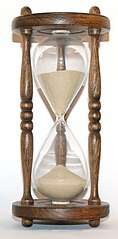Atomic clock achieves record stability
Posted: Fri Aug 23, 2013 4:14 am
http://www.latimes.com/science/sciencenow/la-sci-sn-atomic-clock-stability-nist-20130822,0,6785801.story wrote:
Atomic clocks at the National Institute of Standards and Technology in Colorado have set a record for stability, scientists reported Thursday. Next, scientists will begin to measure the clocks' accuracy in keeping time. (Burrus / NIST)
Atomic clock achieves record stability, holds promise for tech
By Eryn Brown, LA Times, August 22, 2013
<<Atomic clocks built at the official U.S. timekeeping laboratory tick with record-breaking regularity, scientists said — marking an advance that may someday allow researchers to perform new tests of the laws of physics and engineers to perfect technologies such as GPS systems.
The ytterbium optical lattice clocks at the National Institute of Standards and Technology in Boulder, Co., achieved a so-called stability of one part in 10-18. In plain English, that means that “if a clock had been running since the Big Bang, by now it would only be off by one second,” said Vladan Vuletic, a physicist at MIT who was not involved in the work.
Atomic clocks already serve a number of practical purposes: standards bodies like NIST depend on cesium-based clocks to set international definitions of the second and the hertz (a measure of frequency), and global positioning systems use cesium or rubidium clocks for calibration purposes.
But before the record-setting ytterbium clocks can be put to wider use, researchers will have to show that they are accurate as well as stable, said Andrew Ludlow, a physicist at NIST and lead author of a study describing the achievement that was published Thursday in the online edition of the journal Science. That will involve evaluating uncertainty in the clocks: understanding exactly how various influences change the ticking rate of the atoms — such as gravity, magnetic field, and temperature. “At that point, we’ll have both ingredients for measuring time,” Ludlow said.
Since the first accurate atomic clocks were invented in the mid-1950s, scientists have worked on improving the technology. For many years, most atomic clocks were composed of a single charged atom, or ion, that scientists excited using a microwave signal. That signal would stimulate the ion, bringing about a switch between energy levels and creating the ticking of the clock.
So-called optical clocks, like the timepieces Ludlow and his colleagues have been working with at NIST, use lasers instead of a microwave signal. The lasers have a higher frequency than the microwave signals in the older atomic clocks, which means that the optical clocks tick more rapidly. The increased frequency of the ticks makes the clocks more useful, Ludlow said — much as a yardstick that measures down to sixteenths of an inch offers more precision than one that only indicates feet.
To set the new stability record, Ludlow’s team measured the exquisite regularity of their clocks — which shoot lasers at a lattice of 10,000 neutral atoms, obtaining a sort of average ticking rate across the group — by comparing two clocks’ ticking rates to each other. MIT’s Vuletic said the group’s achievement was notable because it happened so quickly. Optical lattice clocks have only been in use for about a decade, and as recently as five to seven years ago their performance lagged being that of microwave-based clocks, said Tom O’Brian, chief of the Time and Frequency division at NIST.
O’Brian, who was not a coauthor on the Science paper, said the huge improvements in the clocks’ stability was a result of improvements to the lasers in the systems — as well as a better understanding of atomic physics among scientists, which allows clock designers to tune the interactions between atoms in the lattices and obtain better performance.
Assuming that the team can also establish high accuracy in the clocks — and Ludlow said he thought it would — scientists will put the timepieces to work. Someday, optical lattice clocks could become the new international standard, or could help industry build GPS systems that can pinpoint locations with centimeter-scale precision.
By examining the subtle effects of gravity, magnetic fields, temperature and other influences on the clocks, users might be able to “turn the clocks around” — look at changes in their tick rates to describe gravitational fields in small areas, for instance. Such tools might be useful to a geologist mapping out an oil field or to a climate scientist tracking a large sheet of ice. “As the clocks get better and better, the number of things you can do with them increases,” said Ludlow.
The next generation of atomic clocks may also be useful to scientists working to test the laws of physics, he added. Atomic clocks have already been used at NIST to test Einstein’s theory of general relativity (it held up). In the future, Vuletic said, physicists might even use the devices to test, via lab experiments, whether fundamental constants in physics are indeed unchanging. (Some researchers have expressed doubts.) “It would be revolutionary if you could show that the speed of light isn’t a constant,” he said.>>
